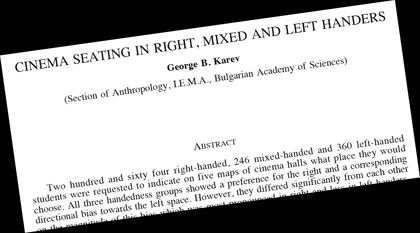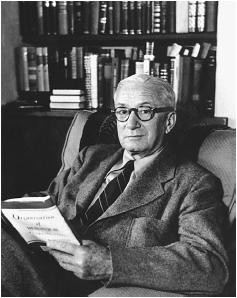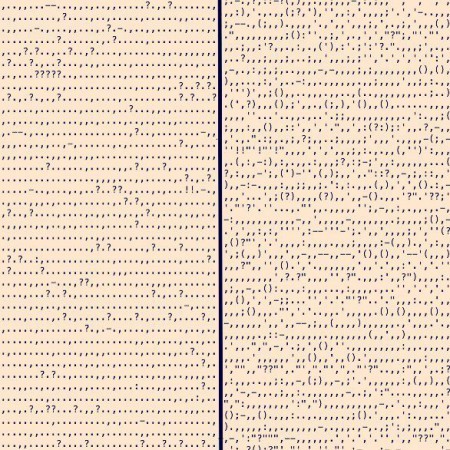Marc Abrahams's Blog, page 278
March 23, 2016
Where do you sit, in Bulgaria? [Podcast 56]
 The problem of whether to sit on the right — or whether to sit on the left, dominates this week’s Improbable Research podcast.
The problem of whether to sit on the right — or whether to sit on the left, dominates this week’s Improbable Research podcast.
SUBSCRIBE on Play.it, iTunes, or Spotify to get a new episode every week, free.
This week, Marc Abrahams —with dramatic readings by Jean Berko Gleason — tells about:
Cinema seating and hand clasping in Bulgaria — George B. Karev, (2000). ‘Cinema Seating in Right, Mixed and Left Handers.’ Cortex 36 (5): 747–52./ –– (1993). ‘Arm Folding, Hand Clasping and Dermatoglyphic Asymmetry in Bulgarians.’ Anthropologischer Anzeiger 51(1): 69–76.

Choosing sides in a theater — Weyers, Peter, Annette Milnik, Clarissa Müller, and Paul Pauli (2006). ‘How to Choose a Seat in Theatres: Always Sit on the Right Side?’ Laterality 11 (2): 181–93. .
Scrotal asymmetry in man and in ancient sculpture — McManus, I. C. “Scrotal asymmetry in man and in ancient sculpture.” Nature 259, no. 5542 (1976): 426-426.
Are all accountants always grey? [this segment is sponsored by Freshbooks] — “Beyond the Boring Grey: The Construction of the Colourful Accountant,” by Ingrid Jeacle, Critical Perspectives on Accounting, 2008. [BONUS: Here’s a video of Ingrid Jeacle describing her research.]
The mysterious John Schedler or the shadowy Bruce Petschek perhaps did the sound engineering this week.
The Improbable Research podcast is all about research that makes people LAUGH, then THINK — real research, about anything and everything, from everywhere —research that may be good or bad, important or trivial, valuable or worthless. CBS distributes it, on the CBS Play.it web site, and on iTunes and Spotify).

March 22, 2016
Questions about Jerry’s Maggot
The questions precede the text. The questions, presented on Ms. Barker’s Science Wiki, are:
Read the attached article titled, Jerry’s Maggot. On a separate sheet of paper respond to the following questions, using complete sentences, based on your knowledge of biology and your personal opinion.
1. What is Jerry’s “problem” and how did he get his “problem”?
2. Describe the life cycle of Jerry’s problem?
3. What was your reaction to how Jerry solved his problem? Would you have done the same thing? If not which option would you have selected?
4. In a food chain what is the relationship between Jerry and his “problem”?
 With those in mind, read, if you will, JERRY’S MAGGOT (from Tropical Nature pp.153-157) edited.
With those in mind, read, if you will, JERRY’S MAGGOT (from Tropical Nature pp.153-157) edited.
(Thanks to investigator Cheryl Ballard for bringing this to our attention.)
BONUS: Jerry is Jerry Coyne (pictured here). The problem alluded to above involved Jerry’s head. And a maggot.

March 21, 2016
Cats in a puzzle box
This video made in 1937 or 1938 documents what happened when cats were placed in a puzzle box:
Edwin Ray Guthrie [pictured here sitting in a room which was, one must admit, a form of box] and G. Plant Horton were the human researchers.


A peer-reviewed journal of one’s own (Žižek Studies)
“For some, the notion of a journal devoted to the work of a theorist very much alive and intellectually kicking is discombobulating.”
– explain the editors of the International Journal of Žižek Studies
“As its title unambiguously proclaims, it is devoted to the work of Slavoj Žižek, a Slovenian philosopher/cultural theorist.”
And yes, Improbable is indeed discombobulated – trying to unravel the peer-review implications. In the sense that if professor Žižek writes articles for the journal which is devoted to his works, how might that affect the reviewers’ objectivity?
Example, see: Is God Dead, Unconscious, Evil, Impotent, Stupid … Or Just Counterfactual? IJŽS, Vol 10, No 1 (2016)
If you’re aware of any other peer-reviewed journal devoted to the work of an individual, and where that individual writes for the journal, and is on the Board of the journal, please share it with our readers by commenting below.
Many thanks to Ivan Oransky for his assistance.

Ig Nobel Wednesday night in Lausanne
Join us at EPFL in Lausanne for the Ig Nobel show, on Wednesday, March 23 — the concluding show on this year’s Ig Nobel EuroTour.
The show features:
Marc Abrahams — founder of the Ig Nobel Prize ceremony
Elisabeth Oberzaucher (University of Vienna)
2015 Mathematics Prize Winner — “Whether and how Moulay Ismael the Bloodthirsty, the Sharifian Emperor of Morocco, managed to father 888 children“
Stephan Bolliger (University of Zurich
2009 Peace Prize Winner — “Is it better to be smashed over the head with a full bottle of beer, or with an empty bottle?“
Emily Baird (Lund University)
2013 Biology and Astronomy Prize Winner — “Dung beetles use the Milky Way for navigation“

March 20, 2016
Ormond explains, TEDxly, how they learned to partially unboil an egg
Callum Ormond explains his part in figuring out how to partially un-boil an egg— an achievement that led to an Ig Nobel Prize. Here’s Ormond’s TEDx talk:
The 2015 Ig Nobel Prize for chemistry was awarded to Callum Ormonde and Colin Raston[AUSTRALIA], and Tom Yuan, Stephan Kudlacek, Sameeran Kunche, Joshua N. Smith, William A. Brown, Kaitlin Pugliese,Tivoli Olsen, Mariam Iftikhar, Gregory Weiss [USA], for inventing a chemical recipe to partially un-boil an egg.
REFERENCE: “Shear-Stress-Mediated Refolding of Proteins from Aggregates and Inclusion Bodies,” Tom Z. Yuan, Callum F. G. Ormonde, Stephan T. Kudlacek, Sameeran Kunche, Joshua N. Smith, William A. Brown, Kaitlin M. Pugliese, Tivoli J. Olsen, Mariam Iftikhar, Colin L. Raston, Gregory A. Weiss, ChemBioChem, vol. 16, no. 3, February 9, 2015, pp. 393–396.

Why Isn’t Why Simpler?
Richard Feynman, asked a question that begins “Why…”, explains why that kind of question is tough:

March 19, 2016
Algorithmic Distinguishing of Novelists from their Punctuation Patterns
Adam J. Calhoun has written a wonderful blog entry that illustrates, with some great data visualization, that it is possible to algorithmically distinguish different novelists based only on their punctuation habits.
The idea is simple: just remove all words from a corpus of text and look at the patterns of the punctuation. Here is an illustration.

Punctuation in (left) “Blood Meridian” by Cormac McCarthy and (right) “Absalom, Absalom!” by William Faulkner
I’ll now punctuate this blog entry with Calhoun’s description of the poignant differences in this illustration:
In fact, they can be quite distinct. Take my all-time favorite book, Absalom, Absalom!by William Faulkner. It is dense prose stuffed with parentheticals. When placed next to a novel with more simplified prose — Blood Meridian, by Cormac McCarthy — it is a stark difference (see above).
Calhoun has made his code freely available, so you can try this for yourself. Hmmm… I wonder if we can gain some insights into the different writing styles of different scientists this way?
(Tip of the hat to the folks at the Santa Fe Institute for bringing this story to our attention.)

March 18, 2016
Which seals have the stiffest whiskers?
Pinnipeds (for example seals) tend to have vibrissae (i.e. whiskers) of varying flexurality (stiffness), arranged in a mystacial (moustache-like) format. Warranting an experimental investigation:
“This is the first comparative study on the mechanical properties of pinniped mystacial vibrissae.”
– explain a team of researchers from Texas A&M university and West Chester University, US. 
The investigators mechanically tested [see photo] the whiskers of Gray seals, Harbor seals, Harp seals, Ringed seals, Spotted seals, Weddell seals, Bearded seals, California sea lions, Guadalupe fur seals, Northern fur seals and South American fur seals as cantilever beams, in order to gauge their flexural stiffness (when both wet and dry). Finding that Fur seals’ whiskers had the largest flexural stiffness and Gray seals’ the lowest.
“We suggest that the variation in flexural stiffness in pinniped vibrissae results in variation in resonance frequencies of hair shafts that interact with the beaded morphology to provide a greater resolution of hydrodynamic reception in phocid seals with beaded vibrissae.”
The team also note the opportunities for further research, suggesting that seals’ rhinal vibrissae (nose hairs) and superciliary vibrissae (eyebrows) might also warrant investigation.
See: Ginter Summarell CC, Ingole S, Fish FE, Marshall CD (2015) Comparative Analysis of the Flexural Stiffness of Pinniped Vibrissae. PLoS ONE 10(7): e0127941.
Also see: Growth rates of whiskers: Seals vs Sea Lions

March 17, 2016
Do orangutans prefer functional tools or non-functional tools?
Orangutans (Pongo spp.) have been observed to spontaneously use tools of various kinds to achieve their objectives. But researchers from The Great Ape Trust, Des Moines, IA, and Iowa State University wondered whether, given the choice, they might prefer to go for a functional tool (stiff) or a non-functional (floppy) tool. Their experimental study presented three orangutans (Allie, Azy and Knobi) with a previously unseen choice of tools to get at a food reward placed just out of their reach. The three sets of tools, a wooden stick, a piece of hose and a PVC tube (all 75 cm long) were presented in pairs, one of which was stiff and rather useful, and the other floppy and relatively useless. [see photo]
“The functional tool was selected in nearly all trials. Moreover, two of the orangutans demonstrated this within the first test trials with each of the three tool types.”
See: Orangutans (Pongo spp.) May Prefer Tools With Rigid Properties to Flimsy Tools, Journal of Comparative Psychology, 2010, Vol. 124, No. 4, 351–355.

Marc Abrahams's Blog
- Marc Abrahams's profile
- 14 followers





